
Università degli Studi di Pavia
Centro Interdisciplinare di Bioacustica e Ricerche Ambientali
Software for sound analysis - Windows
The development of dsp techniques and of
low-cost high-speed computer hardware with large hard
disks has made the computer analysis of bioacoustical
signals an every-day invaluable tool for ethological
research and for monitoring the underwater environment.
The Windows environment offers many advantages over DOS.
The drawback is that Windows requires a lot of hardware
resources: mainly RAM and CPU power. A same task, on a
same machine, may be 10 times slower in Windows than in
DOS. Fortunately, CPU speed continues to increase while
prices decrease. This fact induced to begin the
development of a completely new analysis software able to
run in windows. Capabilities and features now available on
todays's machines were a dream only few years ago; visit
the DSPW pages to
know more about the evolution of the hardware and the
development of this software.
The new software was released for
internal use in 1997 with the name wSpecGram
but was then definitively named SEA (Sound Emission
Analyzer). It runs in any windows version and
uses any installed windows-compliant sound device,
including digital I/O boards and boards with up to 8
channels at 192 kHz. The software is also able to fully
exploit the capabilities of the new Dodotronic UltraMic200k and UltraMic250k,
ultrasonic microphones with incorporated AD and USB port
able to receive ultrasounds up to 120 kHz. The software
works well on notebooks and tablet pcs too and this makes
it a great tool for field research. The software is
available in two versions, SeaWave
that is free for personal non profit use, and SeaPro for professional and
institutional use. Advanced versions for specific research
are also available for CIBRA and its partners.
As it is based on Windows it provides
ease of use and full compatibility with the sound devices
and sound analysis software available on the market.
The software includes analysis, recording and display
tools, with real-time spectrogram and cepstrogram,
spectral averaging, frequency tracking, event counting,
scheduled recording, etc..
Other features include: 1 or 2 channels, real-time
spectrogram display, real-time cepstrogram display,
wrap-around or scrolling display, wide control on all
analysis parameters, frequency-time cursor while in
real-time mode, FFT size up to 16k points, frequency zoom
capabilities with real-time spanning, frequency tracking,
file analysis, file play with real-time display, drag
& drop file play, play list management with real-time
file concatenation, file recording with real-time display,
display up to 3840x1200 pixels and compatibility with
rotated and multiple displays, screen save in .bmp format.
Sound files and spectrograms are saved in a standard
format to allow further processing with other software.
To fullfill the requirements of acoustic surveys,
recording capabilities have been expanded by adding
scheduled recording capabilities, on event recording, gps
position logging, and a continuous survey mode to record a
file each hour until all the available disks space is
filled. By using a RAID controller with, say, 4x80GB
disks, it records for 17 days (stereo, 16 bit wav, 48kHz
sampling). HD support is now upgraded to manage multiple
disks up to 2TB each. More functions are in development,
in particular for detecting and classifying acoustic
events.
Depending on the installed sound acquisition devices,
analog I/O is allowed in the audio frequency range and/or
in the ultrasonic range up to 48 and 96kHz (96 and 192 kHz
sampling respectively). Digital I/O
by means of PCI boards, USB devices or FireWire devices is
also possible to provide direct transfer from DAT
recorders or other digital systems to the PC.
An advanced version, named SEADAQ, has been developed to support very fast sampling rates for studying ultrasounds extending to more than 200 kHz. This version uses National Instruments DAQ devices that include PCI boards, PCMCIA cards and FireWire data acquisition peripherals with sampling rates up to MHz sampoling. By using a PCMCIA card in a fast notebook it is possible to acquire, record and display in real time ultrasounds with sampling rates up to 500 kHz sampling.
High resolution real-time capabilities, typically available in much more expensive instruments, are very useful in field experiments to monitor the acoustic activities of the emitting subjects (immediate correlation among observed behaviours and emitted/received signals) and to optimise the instrumental setup (minimisation of noise, transducer placement, verification of the recording chain). These facilities allow to immediately evaluate the results of an experiment instead of waiting for later analyses on the recordings, and they make easier to analyse long periods. A portable version based on a notebook can be easily moved across laboratories or used in on-field applications, for example those requiring real-time visualization and recording of acoustic events. Real-time capabilities and the continuous recording to disk with GPS position logging are particularly suitable for the continuous monitoring of underwater environment and for carrying out wide area acoustic surveys for both scientific and mitigation needs. By using a GIS it is then possible to map survey tracks and to plot the detected acoustic events in real-time.
The classification of received acoustic events, either biological or artificial sounds, is still a challenge. A trained observer is normally able to correctly classify basic sound categories in real-time by join listening with spectrogram observation; though this is a very demanding task and requires skilled operators. Doing the job 24/24h for long periods may be prohibitive. This is why it is required to develop reliable sound classification algorithms for working in real-time or for post processing long recordings. Such algorithms have been developed for very specific uses and can't be applied to generic tasks yet.
To know more visit the page dedicated to the SeaPro software suite and see spectrogram samples on the pages on Soundscapes, on birds and on Marine Mammals' voices.
Other software developed at CIBRA
SEAcommander
a software to remotely control a SEAPro/SEAUltra running
on a networked PC
CatWav
a program to catalog .wav files
SlotLogger
classification of received signals & distribution of
data by UDP; works on 1 minute time slots
EventLogger
software to log acoustic detections and other events
NMEAManager
management of serial NMEA data and broadcast by UDP,
conversion of serial to UDP and back; it is required to
make GPS information available to SeaPro for georeferenced
filenaming
UDPMonitor
display & log UDP messages; useful to monitor GPS data
and other information transmitted through UDP
OziManager
feed OziExplorer with NMEA data received on UDP port (for
example NMEA data distributed by NMEAManager)
ArcUDP
VBA extension to ArcView 8.2 to receive and plot UDP data
generated by NMEAManager, SlotLogger and EventLogger
WhaleSizer
a software to assess in real-time the size of sperm whales
by displaying and measuring the Inter Pulse Interval (IPI)
computed by means of cepstrum analysis.
WaveBeamformer
based on the WaveRecorder, this software allows to perform
beamforming in the time domain. It allows to record either
the original channels or the beamformed ones. It also
allows to select any 2 beams for listening and/or for
recording. It works on up to 96 channels with sampling
rate up to 192ks/s. Spacing of the sensors must fit the
beamformer parameters.
WaveRecorder (developed for the
NEMO-ONDE Project)
a multichannel recorder (1-96 channels; up to 192ks/s; 16,
20 or 24 bits; stores data in 16bits, 32bits, or Float
format; scheduled recording)
WaveRecorder2x2 (developed for the
NEMO-ONDE Project)
4 channels recorder able to get in synch two stereo boards
(4 channels; up to 192ks/s; 16, 20 or 24 bits; stores data
in 16bits, 32bits, or Float format; scheduled recording)
SeaPro4ch (developed for the NEMO-ONDE
Project)
special version of SeaPro/SeaUltra able to read and play 4
channels wav files recorded with WaveRecorder. It allows
to select two channels for play/display any 2 channels of
the 4 stored in the file. This ability will be
incorporated soon in the SeaPro/SeaUltra.
SeaDSP
this software works in post-processing only to
manipulate files; it allows many processing functions
including filtering, downsampling, and band shifting to
shift ultrasonic components into audible range. It also
performs spectral compression to compress a wideband
spectrum into the audible range.
SeaNET
still in experimental stage, this SeaPro/Ultra
option allows to analyze/record sounds distributed on the
network by the software AudioGem.
Examples
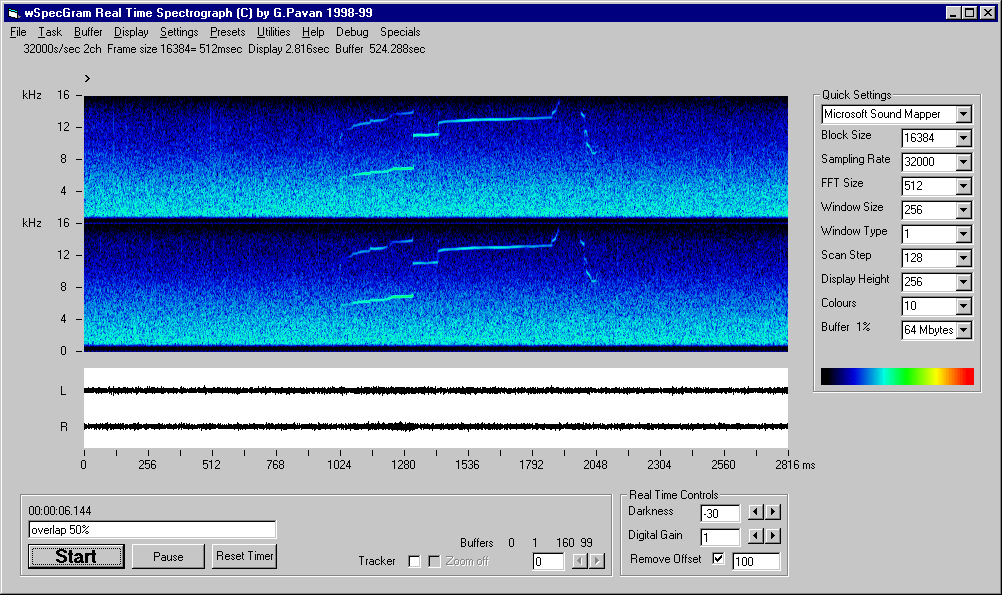
The wSpecgram display in 2 channels mode.
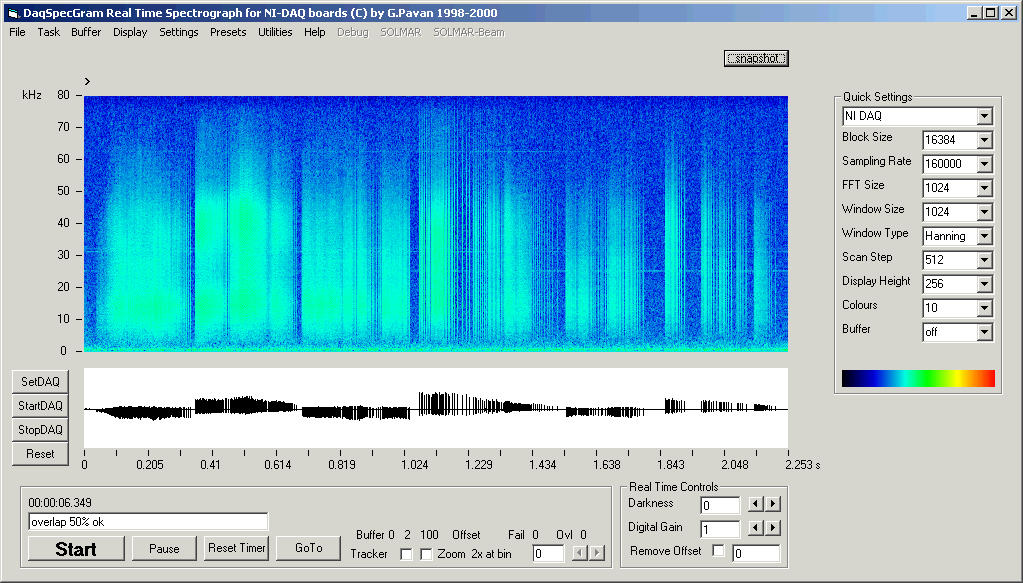
Screenshot of SEADaq showing pulse trains emitted by an ant.
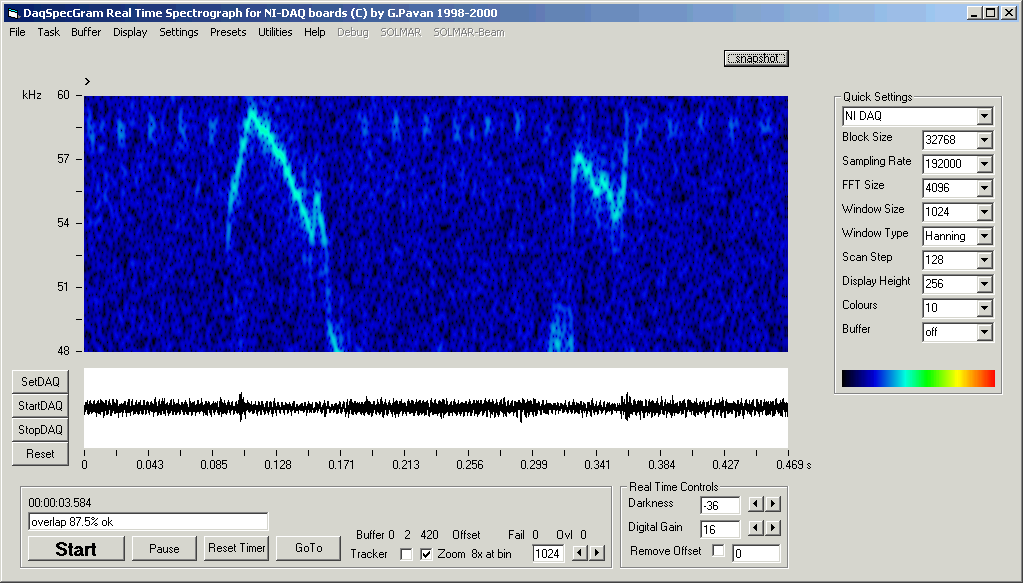 SEADaq
showing mice calls in the range 48 to 60 kHz
(frequency zoom mode).
SEADaq
showing mice calls in the range 48 to 60 kHz
(frequency zoom mode).
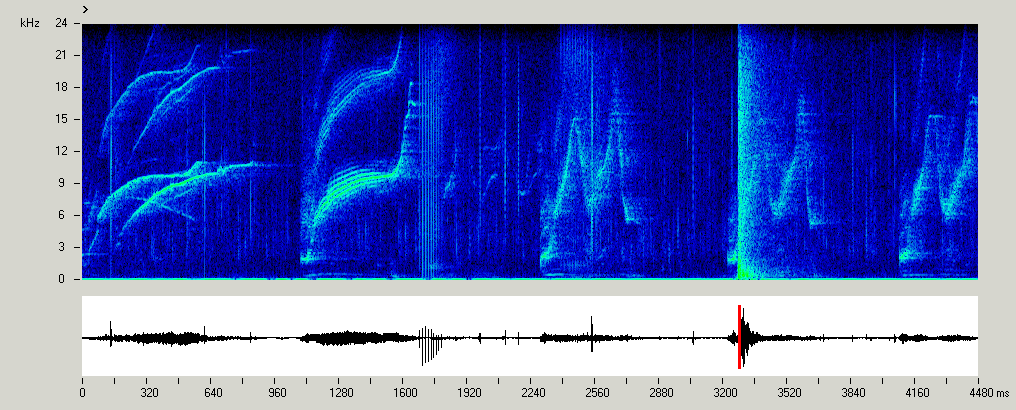
Whistles, clicks and bangs emitted by a bottlenose dolphin.
Software for sound analysis - DOS
DOS programs were developed to fully exploit the capabilities of CPUs and sound boards available until few years ago. Visit the DSPW and History pages to know more about the development of this software and the constraints imposed by hardware. The software was developed to support the following signal acquisition boards:
- Audiologic Duetto (recording, playback, real-time analysis, up to 48k s/s)
- Audiologic AudioBoard Plus with digital I/O (recording, playback, real-time analysis, up to 48k s/s)
- Microstar DAP 2400 series (ultrasound recording and real-time analysis, up to 320k s/s)
- Creative SoundBlaster 16/32/AWE and true compatibles (recording, real-time analysis, 5 to 44.1k s/s)
Download the software, install it, run it and then email us for registration (see below) and further info.
Hardware requirements: a PC with
at least a 486DX2/66 CPU (faster CPUs allow smoother
display and wider control on analysis parameters), a VGA
graphic board, a Creative SoundBlaster 16/32/64 or a true
compatible (Vibra16 chipset seems to work well too).
The sound board must be correctly installed with the SET
BLASTER command string in the autoexec.bat file. It is
strictly required the high DMA channel set to 5, 6 or 7.
The software requires to run in MS-DOS mode; it can be run
in Win95/98 in full screen DOS mode as well.
Installation: create a directory just below the
root, unzip the files in that directory, read carefully
the help file (sbrta.hlp - a plain text file), run the
sbrta program: a short beep will say that the board has
been recognized. If something goes wrong, please report to
the Author all the information on the welcome screen.
Registration: when you run it for the first time,
the program will check for a properly configured suitable
sound board; if everything is ok it sounds a beep and then
displays a SiteCode, unique for you PC, and it prompts for
a Password. Email the SiteCode to gianni.pavan@unipv.it
to get your own Password. The registration is free! It is
required to keep track of the circulating copies of the
software.
Software features: Hard Disk recording and/or
real-time spectrographic display up to 44100 samples/sec.
Wide control on all the analysis parameters (FFT 256, 512
and 1024 points; several wheighting functions with zero
padding and overlap up to 93.75%; frame skipping, frame
packing, and frame averaging). Three display modes
(wrap-around and scrolling horizontal display; four strips
scrolling display; vertical scrolling display).
Spectrogram and envelope display. Real-time cepstrogram
display. Frequency tracking. On screen cursor. Several
colour tables. Screen save to .bmp file.
Examples
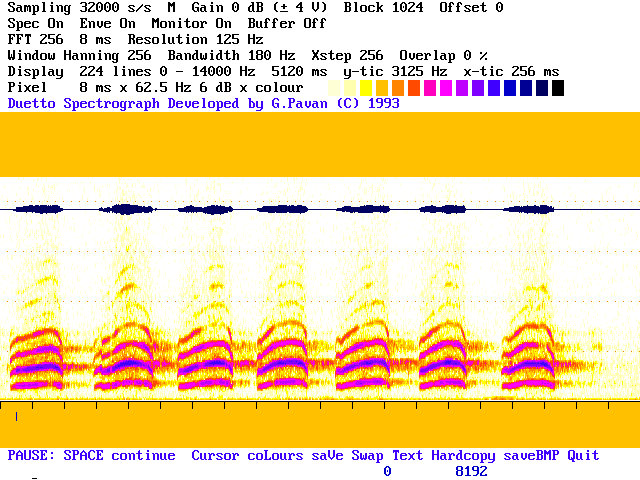
Repeated bird calls as shown by the
Duetto software.
The envelope plot (black trace) is overlaid on the
0-14kHz colour spectrogram.
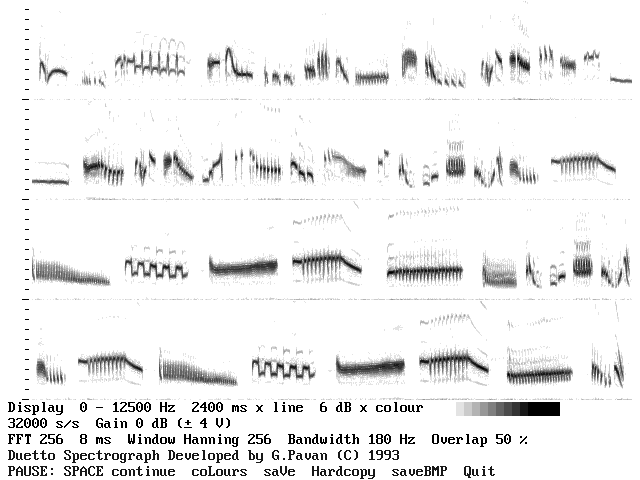
A bird song shown in four black & white spectrogram strips.
Page compiled by Gianni Pavan, last update August 2012.